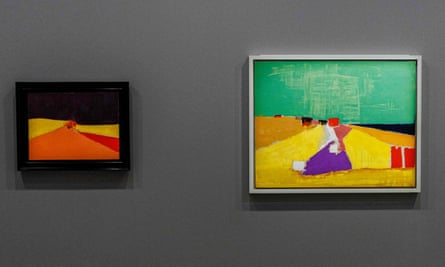Introduction
The life of Nicolas de Staël, a Russian-born French artist, was characterised by turbulence, tragedy, and a relentless pursuit of artistic expression. Forced into exile by the 1917 revolution, orphaned at a young age, and often unlucky in love, De Staël’s story has been overshadowed by the myth of his tragic end. However, a new exhibition at the Museum of Modern Art in Paris seeks to reposition his art at the centre of his narrative, showcasing more than 200 paintings, drawings, engravings, and notebooks, many of which have never been seen in public before.

The Enigmatic Artist
Nicolas de Staël was born Nicolaï Vladimirovitch Staël von Holstein into a high-ranking military family in St. Petersburg, Russia, during the tsar’s rule. However, the 1917 revolution forced his family into exile when he was just three years old. Tragically, his parents passed away shortly thereafter, leaving De Staël and his sisters in the care of a Russian couple in Belgium.
De Staël’s journey as an artist began after he studied art in Brussels and then traveled extensively through the south of France, Spain, and Morocco. It was in Morocco that he met his first wife, Jeannine, a fellow artist, and embarked on a passionate but tumultuous relationship.
Struggles and Triumphs
De Staël’s life was marked by financial hardship, especially during his early years in Nice and Paris with Jeannine. They lived in extreme poverty, resorting to burning furniture for warmth during harsh winters. In 1946, Jeannine tragically passed away after terminating a pregnancy that posed a severe risk to her life.
Within months of Jeannine’s death, De Staël remarried, this time to Françoise Chapouton, and relocated his family to the south of France. However, his heart was soon captivated by Jeanne Polge, a married mother of two. This tumultuous love affair led to a furious burst of creativity and the creation of his monumental work, “Le Grand Concert: L’Orchestre,” before he tragically took his own life.

The Myth and the Man
De Staël’s tumultuous personal life and tragic end have often overshadowed his artistic accomplishments. The myth of his troubled personality has prevented many from appreciating the beauty and depth of his oeuvre, which serves as a celebration of existence itself. Fabrice Hergott, the director of the Museum of Modern Art in Paris, emphasises the need to reevaluate De Staël as a great, original, and atypical painter.
Legacy and Reflections
Despite the myth that surrounds his life and death, Nicolas de Staël’s final works are brimming with life and vitality, contradicting the notion of a melancholic artist. He devoted himself entirely to his craft, seeking solitude to give his maximum to his paintings. The artist’s youngest son, Gustave de Staël, believes that if someone had been with his father during his final moments, he might not have chosen to end his life.
Conclusion
The exhibition at the Museum of Modern Art in Paris serves as a vital step in reevaluating Nicolas de Staël’s legacy. Beyond the tragic narrative, it highlights his exceptional talent, prolific career, and the enduring beauty of his art. Through this showcase, De Staël’s works beckon us to appreciate the vibrant celebration of existence that he painted on canvas, leaving behind a legacy that transcends the myth of his life’s troubled trajectory. Nicolas de Staël’s art continues to remind us that even in the face of personal turbulence and tragedy, the human spirit can find profound expression and beauty
Feature Image: Nicolas de Staël in 1954. Courtesy: Denise Colomb/RMN-Grand Palais

Contributor





